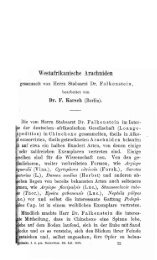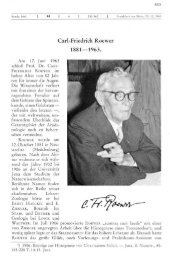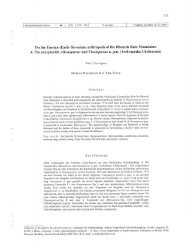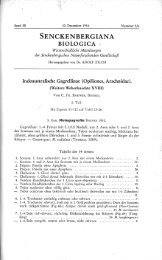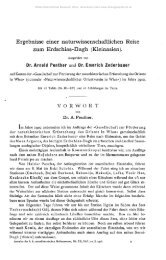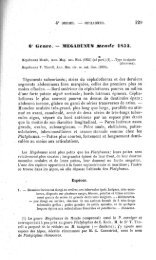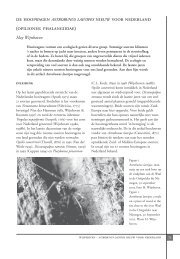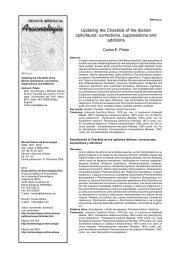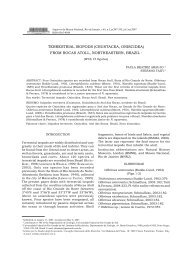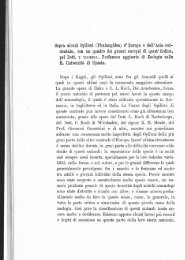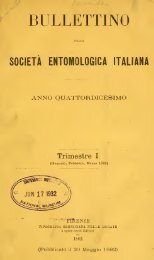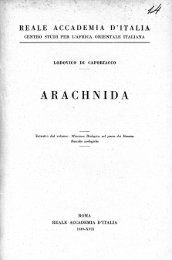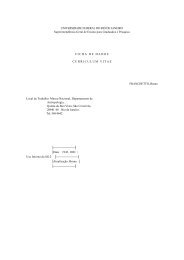Starega 2004 Metaphalangium.pdf - Museu Nacional
Starega 2004 Metaphalangium.pdf - Museu Nacional
Starega 2004 Metaphalangium.pdf - Museu Nacional
You also want an ePaper? Increase the reach of your titles
YUMPU automatically turns print PDFs into web optimized ePapers that Google loves.
ARTÍCULO:<br />
On some species of<br />
<strong>Metaphalangium</strong> Roewer from<br />
the Mediterranean Region<br />
(Opiliones, Phalangiidae)<br />
Wojciech Star“ga<br />
Instytut Biologii<br />
Akademia Podlaska<br />
ul. Prusa 12<br />
08-110 Siedlce, Poland<br />
wojstar@neostrada.pl<br />
address for correspondence:<br />
Kinowa 24/77<br />
04-017 Warszawa, Poland<br />
Revista Ibérica de Aracnología<br />
ISSN: 1576 - 9518.<br />
Dep. Legal: Z-2656-2000.<br />
Vol. 9, 30-VI-<strong>2004</strong><br />
Sección: Artículos y Notas.<br />
Pp: 235–240.<br />
Edita:<br />
Grupo Ibérico de Aracnología<br />
(GIA)<br />
Grupo de trabajo en Aracnología<br />
de la Sociedad Entomológica<br />
Aragonesa (SEA)<br />
Avda. Radio Juventud, 37<br />
50012 Zaragoza (ESPAÑA)<br />
Tef. 976 324415<br />
Fax. 976 535697<br />
C-elect.: amelic@telefonica.net<br />
Director: A. Melic<br />
Información sobre suscripción,<br />
índices, resúmenes de artículos on<br />
line, normas de publicación, etc. en:<br />
Indice, resúmenes, abstracts vols.<br />
publicados:<br />
http://entomologia.rediris.es/sea/<br />
publicaciones/ria/index.htm<br />
Página web GIA:<br />
http://entomologia.rediris.es/gia<br />
Página web SEA:<br />
http://entomologia.rediris.es/sea<br />
ON SOME SPECIES OF METAPHALANGIUM<br />
ROEWER FROM THE MEDITERRANEAN REGION<br />
(OPILIONES, PHALANGIIDAE)<br />
Wojciech Star“ga<br />
ARTÍCULO:<br />
Abstract:<br />
The following three species are described: <strong>Metaphalangium</strong> corsicum (Roewer, 1956)<br />
(transferred from Eudasylobus), M. lusitanicum (Roewer, 1956) (transferred from<br />
Dasylobus) and M. sudanum Roewer, 1961. Dentizacheus zuluetai Rambla, 1959 and<br />
Eudasylobus rondaensis Kraus, 1959 were synonymized with M. lusitanicum, and<br />
<strong>Metaphalangium</strong> orientale Star“ga, 1973 with M. sudanum. The last mentioned species<br />
is the first harvestman known from Saudi Arabia. The genus <strong>Metaphalangium</strong> Roewer<br />
now comprises 7 species and probably one more, M. abruptum (Roewer, 1911)<br />
(transferred from Paropilio, with Zacheus mirabilis Caporiacco, 1949 as a synonym) –<br />
this should be, however, checked. <strong>Metaphalangium</strong> propinquum denticulatum Hadñi,<br />
1973 and M. propinquum montenegrinum Hadñi, 1973 are synonymized with M. cirtanum<br />
(C.L. Koch, 1839), and Dasylobus nigricoxis Simon, 1878 removed from synonymy with<br />
M. cirtanum.<br />
Key words: Opiliones, Phalangiinae, <strong>Metaphalangium</strong>, harvestmen, Mediterranean Region,<br />
Saudi Arabia.<br />
Taxonomy:<br />
<strong>Metaphalangium</strong> corsicum (Roewer, 1956) comb. n.<br />
<strong>Metaphalangium</strong> lusitanicum (Roewer, 1956) comb. n.<br />
<strong>Metaphalangium</strong> abruptum (Roewer, 1911) comb. n.<br />
Sobre algunas especies de <strong>Metaphalangium</strong> Roewer de la región Mediterránea<br />
(Opiliones, Phalangiidae)<br />
Resumen:<br />
(Roewer, 1956) (transferida desde Dasylobus) y M. sudanum Roewer, 1961. Dentizacheus<br />
zuluetai Rambla, 1959 y Eudasylobus rondaensis Kraus, 1959 se sinonimizan con<br />
M. lusitanicum, y <strong>Metaphalangium</strong> orientale Star“ga, 1973 con M. sudanum. La última<br />
especie mencionada es el primer opilión conocido de Arabia Saudí. El género<br />
<strong>Metaphalangium</strong> Roewer contiene actualmente siete especies, más otra probable, M.<br />
abruptum (Roewer, 1911) (transferida desde Paropilio, con Zacheus mirabilis<br />
Caporiacco, 1949 como un sinónimo) – deben ser todavía verificadas las sinonimias de<br />
<strong>Metaphalangium</strong> propinquum denticulatum Hadñi, 1973 y M. propinquum montenegrinum<br />
Hadñi, 1973 con M. cirtanum (C.L. Koch, 1839); se revoca la sinonimia de Dasylobus<br />
nigricoxis Simon, 1878 con M. cirtanum.<br />
Palabras clave: Opiliones, Phalangiinae, <strong>Metaphalangium</strong>, Región Mediterránea, Arabia<br />
Saudí.<br />
Taxonomía:<br />
<strong>Metaphalangium</strong> corsicum (Roewer, 1956) comb. n.<br />
<strong>Metaphalangium</strong> lusitanicum (Roewer, 1956) comb. n.<br />
<strong>Metaphalangium</strong> abruptum (Roewer, 1911) comb. n.<br />
Introduction – the genus <strong>Metaphalangium</strong> Roewer<br />
The genus <strong>Metaphalangium</strong> has been erected already by Roewer (1911) but its<br />
precise characteristics was fixed only just by myself (Star“ga, 1984; some elements<br />
in Martens, 1978). Martens (1978) considered the genus should contain only two<br />
species and the numerous described names be synonymized either with <strong>Metaphalangium</strong><br />
propinquum (Lucas, 1846) or with M. orientale Star“ga, 1973. My earlier<br />
revision (Star“ga, 1984) has shown that to this group belong actually: M. albounilineatum<br />
(Lucas, 1846), M. bispinifrons (Roewer, 1911), M. cirtanum (C.L. Koch,<br />
1839), M. orientale, M. tuberculatum (Lucas, 1846) and a slightly „mysterious” M.<br />
sudanum Roewer, 1961. All mentioned species occur in North Africa, only<br />
albounilineatum and cirtanum have a wider range: the former living also in southern<br />
Italy, the latter nearly in all north Mediterranean countries. My unpublished data<br />
allowed to assign here two further Mediterranean species: M. corsicum (Roewer,<br />
1956) [described as Eudasylobus], M. lusitanicum (Roewer, 1956) [described as<br />
Dasylobus] and to synonymize M. orientale with M. sudanum. The last mentioned<br />
species has now a range, and is not known from some isolated localities only. To<br />
the genus belongs probably also an additional species, M. abruptum (Roewer, 1911)<br />
[described as Paropilio] from Sicily.
236 W. Star“ga<br />
DIAGNOSIS<br />
The genus <strong>Metaphalangium</strong> can be characterized as<br />
follows (Star“ga, 1984): 1. Carapace in front of eye<br />
mound strongly denticulated, all tergites with transversal<br />
rows of sharp denticles; eye mound up to two times<br />
of its length from the frontal margin, with strong<br />
denticles on the eye rings; supracheliceral lamellae with<br />
large granules or denticles, sometimes forming transversal<br />
rows. 2. Male chelicerae normally stronger (though<br />
similar) as in females, with numerous denticles or<br />
granules on both segments; palps short and without any<br />
longer apophyses, femur most with strong, short denticles<br />
ventrally, tarsus in males with longitudinal strip of<br />
large granules ventrally; legs long and strongly built, at<br />
least the femora with sharp denticles or even thorns<br />
ordered into regular rows; leg I (femur to tibia) in males<br />
mostly thickened. 3. Penis shaft with characteristic<br />
subapical „spoon” dorsally (sometimes reaching to the<br />
half length of the shaft); glans comparatively large, in<br />
profile triangular, in cross-section flat cuneiform. 4. The<br />
most characteristic feature is the body coloration: a<br />
darker saddle broadened angularly in the middle portion<br />
of the abdomen (sometimes only this part of the saddle<br />
is visible) and a distinctly bright (white or yellowish)<br />
stripe reaching from the eye mound to the anal plate.<br />
SPECIES TYPICA (by original designation) Phalangium<br />
propinquum Lucas, 1846 [= <strong>Metaphalangium</strong> cirtanum<br />
(C.L. Koch, 1839)] (Roewer, 1911; Star“ga, 1984).<br />
RELATIONSHIPS. The genus is related first of all with<br />
Bunochelis Roewer, 1923 (two species in Canary<br />
Islands), Graecophalangium Roewer, 1923 (four<br />
species in Makedonia, Greece, Lebanon), Bactrophalangium<br />
Šilhavý, 1966 (two species in Afghanistan,<br />
Tadjikistan, Uzbekistan) and Phalangium Linnaeus,<br />
1758 (unknown number of species in the Mediterranean<br />
and Caucasian countries, only Ph. opilio L. with a huge<br />
natural – Holarctic – range). The differences between<br />
those five genera are limited mainly to the shape of<br />
male chelicerae: nearly “normal” in <strong>Metaphalangium</strong><br />
and differently modified in the other. Some relations<br />
exist also with the Mediterranean Dasylobus Simon,<br />
1879, European-Middle Eastern Rilaena Šilhavý, 1965<br />
and Zachaeus C.L. Koch, 1839 as well as with the<br />
African Cristina Loman, 1902 and Dacnopilio Roewer,<br />
1911.<br />
Included were up-to-date (Star“ga, 1984) six<br />
species, the present paper changes this number to 7 or<br />
even 8 (by substracting one and adding two or three).<br />
Descriptions of the species in question<br />
<strong>Metaphalangium</strong> corsicum (Roewer, 1956) comb. n.<br />
Eudasylobus corsicus Roewer, 1956: 255, pl. 36, figs<br />
24–26.<br />
Figs. 1-7.<br />
MATERIAL. 2%%, 7&& – “Eudasylobus corsicus Rwr.<br />
– 4%%, 5&& – TYPUS. Corsika. [IX.28 Gipfel v. Monte<br />
d’Oro]” (Senckenberg-<strong>Museu</strong>m Frankfurt a. M. R<br />
II/2157/100).<br />
DESCRIPTION<br />
Body in male 6.3–7.0, in female 5.1–8.6 mm long.<br />
Carapace in both sexes densely denticulated (stronger in<br />
females!). Eye mound distant from the frontal margin of<br />
about its length, a little broader as long, flattened and<br />
with a distinct furrow, with numerous sharp denticles on<br />
the eye rings. All tergites with a single transversal row<br />
of denticles (in females denticles partly very small or<br />
even substituted by bristles). Ventral body surface and<br />
all coxae smooth.<br />
Chelicerae of male as in fig. 1, in female also with<br />
some denticles dorsally on the basal segment.<br />
Palpal femur in both sexes with a medio-distal<br />
prominence, thickly covered with bristles. Patella with<br />
a short, lobi- or fingerform apophysis. Tibia slightly<br />
thickened medio-apically, brush-like hirsute. Palpal<br />
femur and patella in males with small denticles dorsally,<br />
tibia with very small granules medio-subapically and<br />
tarsus with longitudinal row of granules ventrally in its<br />
middle part. Tarsus characteristically bent. Palps in<br />
female stronger armed: femur and tibia with ventral<br />
spines, patella and tibia dorsally as well as tarsus<br />
ventrally with long, protruding bristles.<br />
Femora to tibiae of legs slightly five-edged and<br />
with longitudinal rows of denticles. In males I Pair<br />
thickened. Legs of moderate length in males (BLI 1<br />
1.375–1.486), short in females (BLI 0.825–1.051;<br />
middle value for 7 specimens 0.944).<br />
Penis (with body length 6.3) 2.85 long, basis 0.49<br />
broad, glans 0.48 and stylus 0.14 mm long.<br />
Coloration of body and appendages yellowishbrown.<br />
Saddle distinct – brown, medially lighter – with<br />
constrictions on 1. and 3–4. abdominal tergite and<br />
bluntly ending on 5. tergite.<br />
DISTRIBUTION. Known from a single locality in Corsica<br />
(Monte d’Oro; Roewer, 1956).<br />
<strong>Metaphalangium</strong> lusitanicum (Roewer, 1956) comb. n.<br />
Dasylobus lusitanicus Roewer, 1956: 251, pl. 36, figs<br />
8–9,<br />
Dentizacheus zuluetai Rambla, 1959: 100–108, figs 33,<br />
35, 37, 39–42, syn. n.,<br />
Eudasylobus rondaensis Kraus, 1959: 302–304, syn. n.,<br />
Zacheus zuluetai: Kraus, 1961: 359,<br />
Dentizacheus zuluetai: Rambla, 1967: 28,<br />
Dasylobus (lusitanicus Roewer 1956?): Rambla, 1967:<br />
29.<br />
Fig. 8-12.<br />
MATERIAL. 1 % – “Dasylobus lusitanicus Rwr. – 1 %<br />
– Typus. Portugal: Coimbra.” (SMF R II/11151/334). 1<br />
% – “Zacheus zuluetai Rambla – 1 %. det. O. Kraus.<br />
Port. (Estremadura): Fatima, H. Franz leg. 31.III.1961.”<br />
(SMF 11889/1).<br />
________________<br />
1 Beinlängenindex [Index of leg length] (Star“ga, 1972):<br />
relation of the femur I length to the carapace width (between<br />
the incisions of coxae II and III).
On some species of <strong>Metaphalangium</strong> from the Mediterranean Region 237<br />
Fig. 1-7. <strong>Metaphalangium</strong> corsicum. 1. Right chelicera of male, mesal view. 2-3: right palpus of male, mesal view:<br />
2. trochanter–patella. 3. tibia and tarsus. 4. right palpus of female, mesal view. 5-6: penis: 5. dorsal view. 6. lateral<br />
view. 7. glans, lateral view. Scale bars in mm.
238 W. Star“ga<br />
Fig. 8-12. <strong>Metaphalangium</strong> lusitanicum. 8. Right chelicera of male, mesal view. 9. right palpus of male, mesal<br />
view. 10-11: penis: 10. dorsal view. 11. lateral view. 12. top of penis with glans, lateral view. Scale bars in mm.<br />
DESCRIPTION<br />
MALE. Body length 3.4 mm. Carapace in front of eye<br />
mound with about 15 sharp, conical denticles, its frontal<br />
corners with numerous short denticles. All tergites with<br />
single transversal rows of denticles (on abdomen<br />
denticles only along the median line, not in straight but<br />
sinuous rows). Eye mound as long as broad, a little<br />
lower, distant from frontal margin of less as its length<br />
(7: 9), furrow very narrow and shallow, eye rings with<br />
4 + 4 denticles.<br />
Chelicerae not enlarged, only 2. segment a little<br />
thickened, frontally with numerous granules; supracheliceral<br />
lamellae with larger denticles.<br />
Pedipalps: patella with short, brush-like apophysis,<br />
femur and tibia densely hirsute, without apophyses;<br />
femur subapically-medially thickly covered with bristles.<br />
Legs moderately long (BLI 1.238), all segments<br />
cylindrical. Femora with longitudinal rows of short<br />
denticles, several denticles also on patellae; other<br />
segments not armed. I pair slightly thickened.<br />
Penis length 2.0 mm. Shaft dorsally with characteristic<br />
rounded subapical „spoon”, dorso-basally with<br />
short, sharp keel. Glans in profile nearly triangular, in<br />
cross-section flat cuneiform, 0.30 mm long; stylus 0.12<br />
mm.<br />
Coloration. Body sides yellowish, with brown<br />
shading; saddle distinct, dark brown, on 1. and 3–4.<br />
abdominal tergite constricted, on 2. and 5. broadened<br />
and on 5. semicircularly ending. A brighter, yellowishbrown<br />
middle line from eye mound till the end of the<br />
saddle. Venter yellowish-white. Appendages yellow<br />
with brown spots and shadows, legs with very strong<br />
brown coating, femora clearly ringed.
On some species of <strong>Metaphalangium</strong> from the Mediterranean Region 239<br />
The above described specimen is one of the<br />
smaller and with weakest armature. Another specimen,<br />
from Fatima, is larger (4.2 mm long) and stronger<br />
armed: 1. cheliceral segment dorsally with a denticulated<br />
bump, 2. swollen and with “Phalangium”–like but<br />
blunt horn. Palpal femur dorsally with denticles. Tibia<br />
and metatarsus I ventrally thickly dotted with granules.<br />
No brighter medial line on the saddle. Eye mound with<br />
5 + 5 denticles. BLI: 1.321. Penis with characteristic<br />
basal keel but the „spoon” somewhat narrower.<br />
The specimens described by Rambla (1959) as<br />
Dentizacheus zuluetai are even larger (body length 5<br />
mm) and stronger armed but the penis structure leaves<br />
no doubt. The original description of Eudasylobus<br />
rondaensis (Kraus, 1959) – though without penis<br />
figures – is also synonymous. The both names shoud be<br />
regarded as synonyms of Dasylobus lusitanicus. The<br />
species should, however, belong to the genus <strong>Metaphalangium</strong><br />
Roewer (as defined by Star“ga, 1984). The<br />
evidences to that are: the shape and armature of chelicerae,<br />
the body coloration and the penis structure.<br />
DISTRIBUTION. Portugal: Coimbra (Roewer, 1956;<br />
Rambla, 1967), Fátima (Kraus, 1961). Spain: south of<br />
Escorial (Sierra de Guadarrama, Prov. Madrid; Rambla,<br />
1959), Sierra de Oreganal near Ronda (Prov. Málaga),<br />
Sierra de Espuña near Murcia (Prov. Murcia), Sierra de<br />
Montsant near La Morera (Prov. Tarragona) (Kraus,<br />
1959).<br />
NOTES. This is probably only a fragment of the<br />
synonymy of the species. In one of my previous papers<br />
(Star“ga, 1973b) I recognized the identity of Dentizacheus<br />
zuluetai with Dasylobus echinifrons Simon, 1879.<br />
One synonymy does not exclude the other (zuluetai =<br />
echinifrons was some kind of hypothesis, now I have<br />
seen some material).<br />
<strong>Metaphalangium</strong> sudanum Roewer, 1961<br />
?<strong>Metaphalangium</strong> propiquum: Roewer, 1953: 204 non<br />
Lucas, 1846,<br />
<strong>Metaphalangium</strong> propinquum: Star“ga, 1967: 58, figs.<br />
4–5 non Lucas, 1846,<br />
<strong>Metaphalangium</strong> sudanum Roewer, 1961: 482–483, pl.<br />
27, figs. 3–4,<br />
<strong>Metaphalangium</strong> orientale Star“ga, 1973a: 138–140,<br />
figs. 21–23, syn. n.<br />
MATERIAL. 1 % – <strong>Metaphalangium</strong> sudanicum – 1 %<br />
– Typus. Sudan COOKE leg. [Original label: “No. 2020<br />
J.A.L.C. 29/12/59, Alt. 2,800, Loc. SINKAT Sudan.<br />
Habitat: under stones. Rocky Hillside”] (SMF R<br />
II/13994/367). 1 & – <strong>Metaphalangium</strong> sudanum Roewer.<br />
– 1 & – Allotyp. Sudan. Cooke leg. [Original label:<br />
“No. 2025. J.A.L.C. 30/12/59. Alt. 2,800’ Loc. SIN-<br />
KAT Sudan. Habitat: under stones, rocky hillside.”]<br />
(SMF R II/13995/368). 1 %, 2 juv. – “Saudi-Arabien:<br />
Shafa, 21s12’N, 40s23’E, 230 m, 21.XII.1982, leg. W.<br />
Büttiker.” 1984 det. W. Star“ga (Coll. J. Martens –<br />
Mainz).<br />
DESCRIPTION: Both sexes strongly armed. In female<br />
carapace and abdomen with numerous denticles, similarly<br />
as the first cheliceral segment dorsally. Palpal<br />
femur dorsally-apically and patella dorsally with some<br />
sharp granules, besides only hirsute. Legs in female<br />
similar as in male, strongly armed. Dimensions: (%)<br />
body 8.0 (Sinkat), 6.6 (Shafa), penis 3.65 (Sinkat), 3.50<br />
(Shafa), glans 0.45, stylus 0.20 (Sinkat); BLI 2.325<br />
(Sinkat), 2.270 (Shafa); (&) body 11.0, BLI 1.902.<br />
The specimens from Sudan and Saudi Arabia are<br />
stronger armed as those from Israel and Egypt – the<br />
Egyptian males (the holo- and paratypus of M. orientale)<br />
were smaller: respectively 7.5 and 6.5 mm long and<br />
had a shorter penis: 2.69 long, glans 0.34, stylus 0.22<br />
mm.<br />
DISTRIBUTION. Israel: ?Wadi Abyad (probably Roewer,<br />
1953 sub M. propinquum), En Radian (Star“ga, 1967<br />
sub M. propinquum). Egypt: Masâra north-west of<br />
Asyüt (Star“ga, 1973a sub M. orientale). Sudan: Sinkat<br />
south of Port Sudan (Roewer, 1961). Saudi Arabia: Ash<br />
Shafa south of Mekka (Coll. J. Martens) – the first<br />
species of harvestman known from the country!<br />
<strong>Metaphalangium</strong> abruptum (Roewer, 1911) comb. n.<br />
Paropilio abruptus Roewer, 1911: 49,<br />
Paropilio abstrusus: Roewer, 1912: 147-148, pl. 2, figs.<br />
1 and 5, part. non L. Koch, 1882,<br />
Paropilio abruptus: Roewer, 1923: 783, fig. 957,<br />
Zacheus mirabilis Caporiacco, 1949: 17-22, syn. n.,<br />
Odontosoma mirabilis: Marcellino, 1970: 304-307, fig.<br />
7A-G.<br />
MATERIAL. 2 juv. – “Paropilio abruptus (Kollar MS)<br />
Roewer 1923. Inv. No. 4128. Sizilien. – Grohmann leg.<br />
Kauf 1833/4. I.58. – Det. (?Kollar) sub: Phalangium<br />
abruptum Kllr.; revid. Roewer (1911 sub: Paropilio<br />
abstrusus (L.K.); d.s. 1923 sub: P. abruptus Kllr. 2<br />
(%,&), “Typen Kollar’s”!) also TYPEN ROEWER’s!<br />
(Gruber rev.): 2 juv. Ex.” (Naturhistorisches <strong>Museu</strong>m<br />
Wien, No. 4128).<br />
I had to my disposal only two juvenile specimens<br />
in very bad condition. Some characters, which could be<br />
checked, e.g. the armature of legs (femora and patellae)<br />
with very long thorns and the body pattern with characterictic<br />
whitish median line, are, however, unmistakable.<br />
It must be the same species described later by Caporiacco<br />
(1949) as Zacheus mirabilis, redescibed by Marcellino<br />
(1970) and transferred to Odontosoma Šilhavý (=<br />
<strong>Metaphalangium</strong> Roewer; Star“ga, 1984).<br />
There is some confusion with the proper name of<br />
the species: Roewer (1911) described it as “abruptus”,<br />
then (1912) synonymized with “abstrusus” from the<br />
Baleares [?synonym of M. cirtanum (C.L.K.) and<br />
probably identical with Phalangium clavipus Roewer,<br />
1911 – anyway different], and revalidated again (1923).<br />
The name “mirabilis” is an additional element of this<br />
mess.
240 W. Star“ga<br />
DISTRIBUTION. Known only from several localities in<br />
Sicily (Roewer, 1911, Caporiacco, 1949, Marcellino,<br />
1970).<br />
Some remarks on other species<br />
1. <strong>Metaphalangium</strong> propinquum denticulatum Hadñi,<br />
1973 and M. propinquum montenegrinum Hadñi,<br />
1973 are, without doubt, synonymous with M.<br />
cirtanum (C.L. Koch, 1839).<br />
2. Dasylobus nigricoxis Simon, 1878, wrongly synonymized<br />
by myself with M. cirtanum (Star“ga, 1984),<br />
must be revalidated (new material in Vienna and<br />
Warsaw).<br />
3. M. cirtanum has been found on Cyprus again (Agia<br />
Napa, 10. Dec. 2001 leg. J. Sawoniewicz – 1 %, 1 &,<br />
2 juv.; Reference Coll. W. Star“ga No. II/0020). It<br />
has been known from that island (Roewer, 1956:<br />
Famagusta).<br />
Acknowledgements<br />
First of all I must very heartlily thank to my friend, Dr M.<br />
Grasshoff (Senckenberg-<strong>Museu</strong>m), for his continual help and<br />
hospitality during all my stays in Frankurt. I owe thanks also<br />
to Prof. J. Martens (Mainz), who gave me possibility to study<br />
interesting material from his personal collection, and to Dr J.<br />
Gruber (Naturhistorisches <strong>Museu</strong>m, Vienna) for giving me<br />
access to very rich collections of his museum. Two grants of<br />
the Deutscher Akademischer Austauschdienst made possible<br />
my visits in Germany in 1971 and 1984.<br />
Bibliography<br />
CAPORIACCO, L. DI 1949. Tre Aracnidi nuovi delle Madonie.<br />
Atti Mus. civ. Stor. nat. Trieste, 17: 17-22.<br />
KRAUS, O. 1959. Weberknechte aus Spanien (Arachn., Opiliones).<br />
Mitt. zool. Mus. Berlin, 35: 293-304.<br />
KRAUS, O. 1961. Die Weberknechte der Iberischen Halbinsel<br />
(Arach., Opiliones). Senckenbergiana biol., 42: 331-<br />
363.<br />
MARCELLINO, I. 1970. Su alcuni Opilioni (Arachnida) della<br />
Sicilia sud-orientale e centrale. Boll. Accad. Gioenia,<br />
ser. IV, 10: 283-308.<br />
MARTENS, J. 1978. Spinnentiere, Arachnida. Weberknechte,<br />
Opiliones. Die Tierwelt Deutschlands, 64, 464 pp.<br />
RAMBLA, M. 1959. Contribución al estudio de los Opiliones<br />
de la Fauna Ibérica. Opiliones de la Sierra de Guadarrama.<br />
Publ. Inst. Biol. apl., 29: 59-110.<br />
RAMBLA, M. 1967. Opiliones de Portugal. Revta. Biol.<br />
Lisboa, 6: 1-34.<br />
ROEWER, C. F. 1911. Übersicht der Genera der Subfamilie der<br />
Phalangiini der Opiliones Palpatores nebst Beschreibung<br />
einiger neuer Gattungen und Arten. Arch. Naturg.,<br />
77I, 2. Suppl., 106 pp.<br />
ROEWER, C. F. 1912. Revision der Opiliones Palpatores (=<br />
Opiliones Plagiostethi). II. Teil: Familie der Phalangiidae.<br />
(Subfamilien: Sclerosomini, Oligolophini, Phalangiini).<br />
Abh. naturwiss. Ver. Hamburg, 20: 1-295.<br />
ROEWER, C. F. 1923. Die Webrknechte der Erde. Systematische<br />
Bearbeitung der bisher bekannten Opiliones. 1116<br />
pp., Gustav Fischer, Jena.<br />
ROEWER, C. F. 1953. Mediterrane Opiliones Palpatores. Abh.<br />
naturw. Ver. Bremen, 33: 201-210.<br />
ROEWER, C. F. 1956. Über Phalangiinae (Phalangiidae,<br />
Opiliones Palpatores). (Weitere Weberknechte XIX).<br />
Senckenbergiana biol., 37: 247-318.<br />
ROEWER, C. F. 1961. Einige Solifugen und Opilioniden aus<br />
der palaearctischen und äthiopischen Region. Senckenbergiana<br />
biol., 42: 479-490.<br />
STAR’GA, W. 1967. Einige Weberknecht-Arten (Opiliones)<br />
aus Israel. Israel J. Zool., 15 [1966]: 57-63.<br />
STAR’GA, W. 1972. Revision der Phalangiidae (Opiliones), I.<br />
Gattung Bunochelis Roewer, 1923. Ann. zool. Warsz.,<br />
29: 461-471.<br />
STAR’GA, W. 1973a. Beitrag zur Kenntnis der Weberknechte<br />
(Opiliones) des Nahen Ostens. Ann. zool. Warsz, 30:<br />
129-153.<br />
STAR’GA, W. 1973b. Bemerkungen über einige westpaläarktische<br />
Weberknechte (Opiliones). Ann. zool. Warsz, 30:<br />
361-373.<br />
STAR’GA, W. 1984. Revision der Phalangiidae (Opiliones),<br />
III. Die afrikanischen Gattungen der Phalangiinae,<br />
nebst Katalog aller afrikanischen Arten der Familie.<br />
Ann. zool. Warsz, 38: 1-79.



